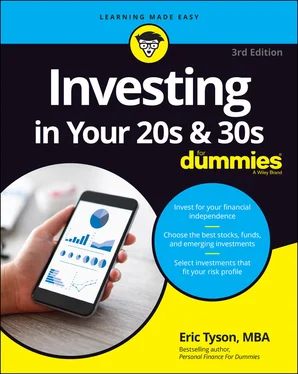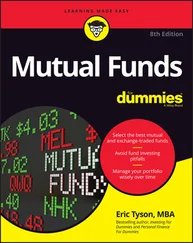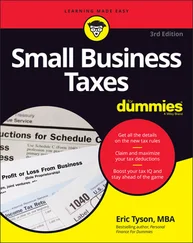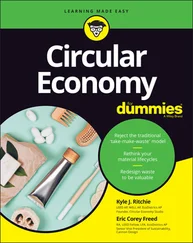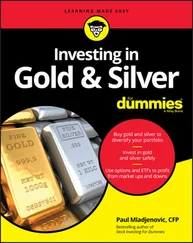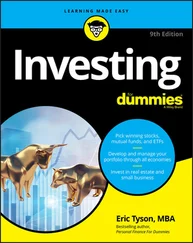Eric Tyson - Investing in Your 20s & 30s For Dummies
Здесь есть возможность читать онлайн «Eric Tyson - Investing in Your 20s & 30s For Dummies» — ознакомительный отрывок электронной книги совершенно бесплатно, а после прочтения отрывка купить полную версию. В некоторых случаях можно слушать аудио, скачать через торрент в формате fb2 и присутствует краткое содержание. Жанр: unrecognised, на английском языке. Описание произведения, (предисловие) а так же отзывы посетителей доступны на портале библиотеки ЛибКат.
- Название:Investing in Your 20s & 30s For Dummies
- Автор:
- Жанр:
- Год:неизвестен
- ISBN:нет данных
- Рейтинг книги:4 / 5. Голосов: 1
-
Избранное:Добавить в избранное
- Отзывы:
-
Ваша оценка:
- 80
- 1
- 2
- 3
- 4
- 5
Investing in Your 20s & 30s For Dummies: краткое содержание, описание и аннотация
Предлагаем к чтению аннотацию, описание, краткое содержание или предисловие (зависит от того, что написал сам автор книги «Investing in Your 20s & 30s For Dummies»). Если вы не нашли необходимую информацию о книге — напишите в комментариях, мы постараемся отыскать её.
Discover your unique investing style!
Inside. . .
Learn how to start investingChoose stocks and funds wiselyMinimize your tax billDecide how much to investGet into real estateManage your level of riskInvest in small businessDiversify your portfolio
Investing in Your 20s & 30s For Dummies — читать онлайн ознакомительный отрывок
Ниже представлен текст книги, разбитый по страницам. Система сохранения места последней прочитанной страницы, позволяет с удобством читать онлайн бесплатно книгу «Investing in Your 20s & 30s For Dummies», без необходимости каждый раз заново искать на чём Вы остановились. Поставьте закладку, и сможете в любой момент перейти на страницу, на которой закончили чтение.
Интервал:
Закладка:
Now look at what happens over 40 years. At a 9 percent investment return, you’ll have more than 21 times as much money versus what you’d have with a 1 percent annual investment return.
Here’s a practical example to show you what a dramatic difference earning a few extra percent can make in accomplishing your financial goals. Consider a 30-year-old investor who’s saving toward financial independence/retirement on his $60,000 annual salary. Suppose that his goal is to retire by age 67 with about $45,000 per year to live on (in today’s dollars), which would be about 75 percent of his working salary.
If he begins saving at age 30, he needs to save about $690 per month if you assume that he earns about 5 percent per year average return on his investments. That’s a big chunk to save each year (about $8,300) — amounting to about 14 percent of his gross (pretax) salary.
But what if this investor can earn just a few percent more per year on average from his investments — 8 percent instead of just 5 percent? In that case, he could accomplish the same goal by saving just half as much: $345 per month (or $4,150 per year)!
Considering your goals
How much do you need or want to earn on your investments?
You have to balance your goals with how you feel about risk. Some people can’t handle higher-risk investments. Although investing in stocks, real estate, or small business can produce high long-term returns, investing in these vehicles comes with greater risk, especially over the short term.
Others are at a time in their lives when they can’t afford to take great risk. If you’re still in school, if you’ve lost your job, or if you’re starting a family, your portfolio and nerves may not be able to wait a decade for your riskier investments to recover after a major stumble.
If you work for a living, odds are that you need and want to make your investments grow at a healthy clip. Should your investments grow slowly, you may fall short of your goals of owning a home or retiring or changing careers.
 All this is to say that you should take the time to contemplate and prioritize your personal and financial goals. If you haven’t already sorted them out, see Chapter 2to get started.
All this is to say that you should take the time to contemplate and prioritize your personal and financial goals. If you haven’t already sorted them out, see Chapter 2to get started.
Chapter 4
Minimizing Your Taxes When Investing
IN THIS CHAPTER
 Seeing how investments are taxed
Seeing how investments are taxed
 Understanding capital gains and dividend taxation
Understanding capital gains and dividend taxation
 Employing strategies to reduce investment taxation
Employing strategies to reduce investment taxation
 Considering tax issues when selling an investment
Considering tax issues when selling an investment
You should pay attention to tax issues when making investing decisions. Actually, let me rephrase that. Like plenty of other folks, you could ignore or pay half attention to taxes on your investments. Unless you enjoy paying more taxes, however, you should understand and consider tax ramifications when choosing and managing your investments over the years.
Tax considerations alone shouldn’t dictate how and where you invest your money. You should also weigh investment choices, your desire and the necessity to take risk, personal likes and dislikes, and the number of years you plan to hold the investment.
In this chapter, I explain how the different components of investment returns are taxed. I also present proven, up-to-date strategies to minimize your investment taxes and maximize your returns. Finally, I discuss tax considerations when selling an investment.
Understanding Investment Taxes
When you invest outside tax-sheltered retirement accounts, the profits and distributions on your money are subject to taxation. (Distributions are taxed in the year that they are paid out; appreciation is taxed only when you sell an investment at a profit.) So the nonretirement-account investments that make sense for you depend (at least partly) on your tax situation.
Tracking taxation of investment distributions
The distributions that various investments pay out and the profits that you may make are often taxable, but in some cases, they’re not. It’s important to remember that it’s not what you make before taxes (pretax) on an investment that matters, but what you get to keep after taxes.
 Interest you receive from bank accounts and corporate bonds is generally taxable. U.S. Treasury bonds, which are issued by the U.S. federal government, pay interest that’s state-tax-free but federally taxable.
Interest you receive from bank accounts and corporate bonds is generally taxable. U.S. Treasury bonds, which are issued by the U.S. federal government, pay interest that’s state-tax-free but federally taxable.
Municipal bonds, which state and local governments issue, pay interest that’s federally tax-free and also state-tax-free to residents in the state where the bond is issued. (For more on bonds, see Chapter 9.)
Taxation on your capital gains, which is the profit (sales price minus purchase price) on an investment, is computed under a unique federal taxation system. Investments held and then sold in less than one year at a profit generate what is called short-term capital gains, which are taxed at your normal marginal income tax rate (which I explain in the next section).
Profits from investments that you hold longer than 12 months and then sell at a profit generate what are called long-term capital gains. Under current tax law, these long-term gains are taxed at a maximum 20 percent rate, except for most folks in the two lowest income tax brackets: 10 percent and 12 percent. For these folks, the long-term capital gains tax rate is 0 percent (as in nothing). Dividends paid out on stock are also taxed at the same favorable long-term capital gains tax rates under current tax law.
The Patient Protection and Affordable Care Act (informally referred to as Obamacare) increased the tax rate on the net investment income for taxpayers with adjusted gross income above $200,000 (single return) or $250,000 (joint return). Net investment income includes interest, dividends, and capital gains. The increased tax rate is 3.8 percent.
Determining your tax bracket
Many folks don’t realize it, but the federal government (like most state governments) charges you different income tax rates for different parts of your annual income. You effectively pay less tax on the first dollars of your earnings and more tax on the last dollars of your earnings. As a wage earner receiving a paycheck, you won’t actually notice or see your actual tax rate rising during the year. The reason: Taxes are withheld at a constant rate from your paycheck based upon estimating your expected income for the year and your total expected tax bill for the year.
Your federal marginal income tax rate is the rate of tax that you pay on your last, or so-called highest, dollars of income (see Table 4-1). Your taxable income is the income that is left after taking allowed deductions on your return.
TABLE 4-12021 Federal Income Tax Rates for Single and Married Households Filing Jointly
| Federal Income Tax Rate | Singles Taxable Income | Married Filing Jointly Taxable Income |
|---|---|---|
| 10% | Up to $9,950 | Up to $19,900 |
| 12% | $9,951 to $40,525 | $19,901 to $81,050 |
| 22% | $40,526 to $86,375 | $81,051 to $172,750 |
| 24% | $86,376 to $164,925 | $172,751 to $329,850 |
| 32% | $164,926 to $209,425 | $329,851 to $418,850 |
| 35% | $209,426 to $523,600 | $418,851 to $628,300 |
| 37% | Over $523,600 | Over $628,300 |
Your actual marginal tax rate includes state income taxes if your state levies an income tax. Though this chapter focuses upon the federal income tax system and strategies to reduce those taxes, most of what is discussed also helps you reduce your state income taxes, which the vast majority of states levy. Each state income tax system is unique, so covering them all here is impossible. All but eight states — Alaska, Florida, Nevada, South Dakota, Tennessee, Texas, Washington, and Wyoming — impose a state income tax. (New Hampshire has only a state income tax on dividend and interest investment income.)
Читать дальшеИнтервал:
Закладка:
Похожие книги на «Investing in Your 20s & 30s For Dummies»
Представляем Вашему вниманию похожие книги на «Investing in Your 20s & 30s For Dummies» списком для выбора. Мы отобрали схожую по названию и смыслу литературу в надежде предоставить читателям больше вариантов отыскать новые, интересные, ещё непрочитанные произведения.
Обсуждение, отзывы о книге «Investing in Your 20s & 30s For Dummies» и просто собственные мнения читателей. Оставьте ваши комментарии, напишите, что Вы думаете о произведении, его смысле или главных героях. Укажите что конкретно понравилось, а что нет, и почему Вы так считаете.
